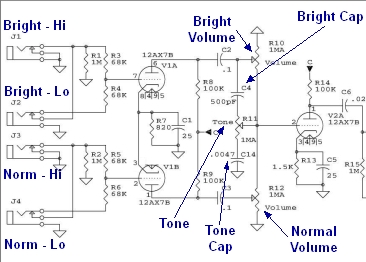untune
Well-known member
Hi all..
I started a preamp project a while back, I'm currently trying to finish it off and build a case for it and I'm going over the design to see what I might be able to improve.
So the second channel is intended to be an instrument amp for bass guitar, straight into a triode connected 6au6. It has more than enough gain but I was curious about the grid stopper, and I chose a 1k2 resistor (can't remember why, likely naively borrowed from another design). Going off bass/guitar inputs this seems a small value. Calculating the miller capacitance for a triode 6au6 I get around 68pF give or take. Combined with the stopper that should give me a LPF with a cutoff of almost 200kHz if I've worked it out right. Seems extremely high.
Calculations again suggested than my ideal grid stopper would be around 120k, which I guess would add too much noise.
An example I read using a 12ax7 (which has a miller capacitance of approx 192pF) suggested the solution would be to pair a 10k resistor and a small cap of 100-470pF before the input to lower noise and create a more fitting low pass filter for input RF interference.
I applied the same logic to my 1k2 and worked out I'd need a cap of about 3000pF to 5600pF for a reasonable filter cutoff.
I expect that there's a disadvantage to having additional capacitance there and I'm curious what the ideal tradeoff is in terms of which component values to choose here. Are there any rules to follow?
Cheers!
I started a preamp project a while back, I'm currently trying to finish it off and build a case for it and I'm going over the design to see what I might be able to improve.
So the second channel is intended to be an instrument amp for bass guitar, straight into a triode connected 6au6. It has more than enough gain but I was curious about the grid stopper, and I chose a 1k2 resistor (can't remember why, likely naively borrowed from another design). Going off bass/guitar inputs this seems a small value. Calculating the miller capacitance for a triode 6au6 I get around 68pF give or take. Combined with the stopper that should give me a LPF with a cutoff of almost 200kHz if I've worked it out right. Seems extremely high.
Calculations again suggested than my ideal grid stopper would be around 120k, which I guess would add too much noise.
An example I read using a 12ax7 (which has a miller capacitance of approx 192pF) suggested the solution would be to pair a 10k resistor and a small cap of 100-470pF before the input to lower noise and create a more fitting low pass filter for input RF interference.
I applied the same logic to my 1k2 and worked out I'd need a cap of about 3000pF to 5600pF for a reasonable filter cutoff.
I expect that there's a disadvantage to having additional capacitance there and I'm curious what the ideal tradeoff is in terms of which component values to choose here. Are there any rules to follow?
Cheers!



